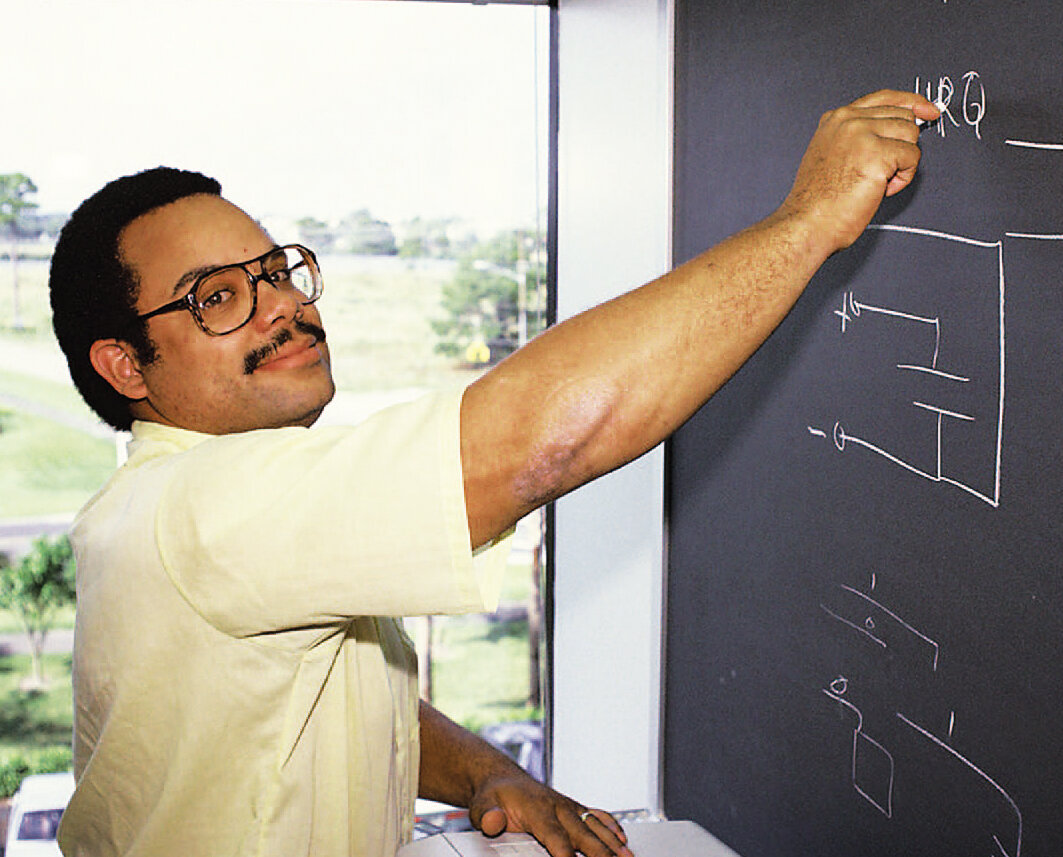Mark Dean
The Groundbreaking Inventor and Computer Engineer
Portrait of Mark Dean. Photo courtesy of University of Tennessee/Mark Dean.
Few have heard of Mark Dean, but his inventions have changed the world we live in. Mark—along with co-inventor Dennis Moeller—created a microcomputer system called Industry Standard Architecture (ISA). ISA is a computer bus protocol developed in the 1980s for 8-bit and 16-bit systems compatible with IBM. The addition of the ISA bus allowed peripheral processing devices attached to a motherboard to communicate with other devices attached to the same motherboard. The potential of the personal computer grew by leaps and bounds via ISA, as users could access ISA slots to add peripherals like printers, modems, video cards, speakers, scanners, disk drives, and other devices, therefore expanding the limits of Information Technology.
Mark Dean with his wife, Paula Bacon, and parents, James and Barbara Dean. Photo courtesy of Mark Dean.
Mark E. Dean was born on March 2, 1957. His place of birth was the town of Jefferson City in eastern Tennessee, home to around 4,500 people at the time. But the town’s black population was minuscule. Mark’s parents were Barbara and James Dean. While his mother’s side of the family had lived in Tennessee for several generations, his father spent his early years on a farm outside Mobile, Alabama. James Dean served in the Korean War and moved to Jefferson City to find work. He was hired onto a maintenance crew for the Tennessee Valley Authority and rose to become a dam supervisor by his early forties. He oversaw a crew that fixed electrical equipment and worked on big turbines and spillway gates. James brought Mark along on work trips at times, and Mark got to see the dam engineers in action, which fascinated him.
Mark admired his father for his mechanical skills. James Dean successfully rebuilt a 1931 Dodge and a 1947 Chevy, and together, he and his son built an entire tractor from scratch. Mark later said of his father:
“There was nothing I was aware of that he couldn’t figure out. If he had grown up in my generation, he would have been an engineer.”
Mark’s grandfather was the principal of a small K-12 school named Nelson Mary. It was segregated and catered to very few students. Mark attended the school in childhood, sitting in a single classroom that served grades one to four. He was so advanced in his studies he found the math lessons to be extremely easy. Mark recalled that:
“One day, in first grade, I came home with a trigonometry book—at least, I remember it was a trigonometry book—and my mother called the teacher and asked if she had made a mistake. But I was already tutoring the fourth graders. It was easy for me. It felt so natural.”
For Mark, English—be it reading or writing—was much more difficult to grasp. English had dozens of characters that were strung together to form words via a spate of complex rules. He admitted he struggled with the subject even in adulthood. But math consisted of ten digits and four operations he could make sense of. By the time he reached third grade, Jefferson City integrated its public schools so Mark no longer attended Nelson Mary. But due to the town’s small black population, Mark was the only black student in all his classes into his high school years.
While he excelled in math, to the annoyance of some of his teachers, white students were perplexed by Mark’s keen grasp of the subject. In middle school, Mark recalled a white friend coming up to him and asking if he was really black because he seemed too smart to be of that ethnicity. While he experienced bigotry growing up, Mark’s parents encouraged him to join integrated sports teams, where he mixed with white teammates and treated them fairly. Before he graduated from middle school, Mark had decided to become an engineer. In high school, he decided to focus on computers, and he would attempt to pursue a career in that field by joining IBM.
After high school, Mark attended the University of Tennessee on a scholarship. He continued to earn stellar grades in college, except for two required English courses. In 1979, Mark graduated at the top of his class regardless and received a bachelor’s in electrical engineering. He went on to earn a master’s and a PhD in electrical engineering as well, from Florida Atlantic University (1982) and Stanford (1992). With his bachelor’s in hand, Mark started interviewing with several corporations that interested him. Hewlett-Packard was one of those companies, and they were so impressed with Mark they offered him a job immediately. But Mark’s heart was still set on IBM.
Mark Dean at IBM in the 1980s, when he was part of the PC development team. Photo courtesy of Mark Dean.
Shortly after graduating from the University of Tennessee, Mark headed to Boca Raton, Florida, which was the home of the IBM office complex at the time. Mark’s first assignment while working at the tech hub was developing an adapter for a word processor that allowed letters and numbers to appear as graphics on the IBM Datamaster terminal screen—the Datamaster was an inexpensive computer that launched in July 1981. This led to Mark joining the IBM personal computer (PC) team and his efforts in helping to design IBM’s first PC. To this end, Mark holds three core patents out of nine on which the PC is based, making him co-inventor of the landmark technology. Two of his three early patents are for adapters related to monochrome and color graphics.
At age 25, Mark became the lead on the ISA project, which created an entire PC ecosystem that became the industry standard due to its efficiency and simplicity. The introduction of the ISA bus system also gave the PC the edge over Apple. Mark created more groundbreaking inventions associated with the PC in the next few years, all of which made the computer more powerful and accessible. Mark’s efforts produced the color monitor. In the late 1990s, Mark moved to Austin, Texas, to lead an engineering team at IBM’s lab in developing the first gigahertz chip. Able to achieve a billion cycles per second, the new chip allowed central processing units to retrieve instructions, interpret them, and complete various tasks at vastly higher clock speeds than the previous multi-megahertz generation of microprocessors.
For his many achievements, Mark became the first black American to be named an IBM fellow in 1995. In the words of IBM:
“The title of IBM Fellow is the company’s pre-eminent technical distinction, granted in recognition of outstanding and sustained technical achievements and leadership in engineering, programming, services, science, design and technology.”
Two years later, Mark was inducted into the National Inventors Hall of Fame. In 2013, Mark’s life took a 360-degree turn when he became a professor of computer science and engineering at the very university from which he received his bachelor’s in engineering more than three decades earlier. Many may not have heard of Mark E. Dean, but his inventions are in use each day.
You may also be interested in:

This article appears in 45 People, Places, and Events in Black History You Should Know.
Available from Amazon.com, BN.com, and other retailers.





Lewis Howard Latimer was a black inventor and engineer who contributed to the patenting and improvement of the incandescent light bulb and the telephone.